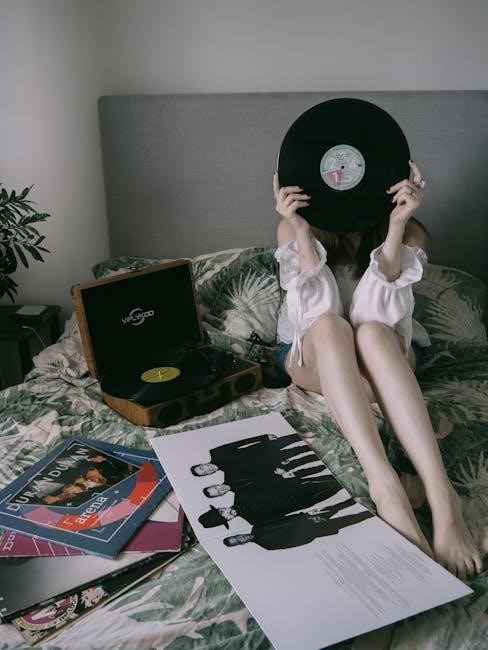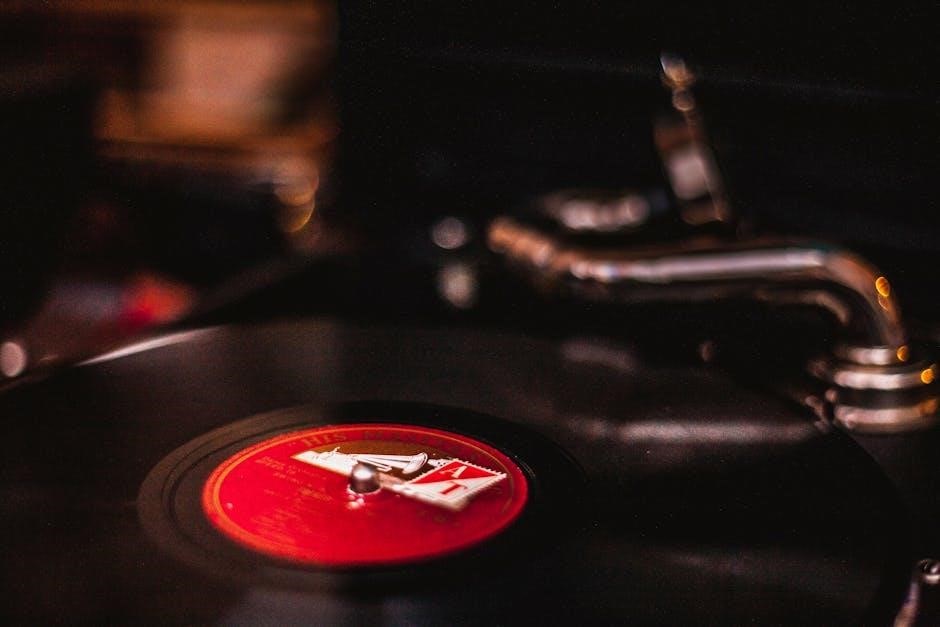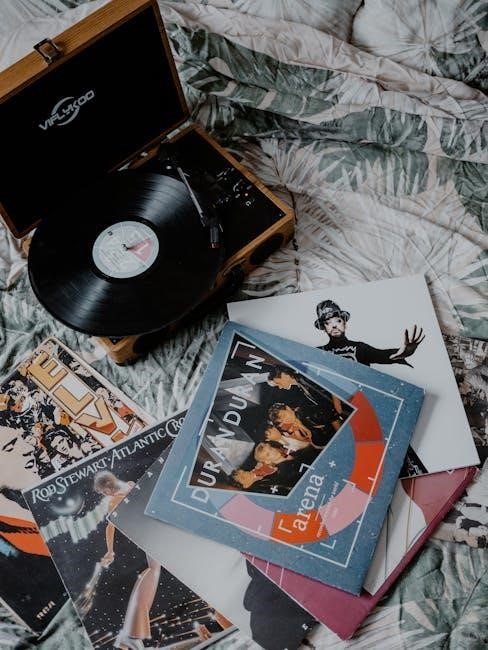Welcome to the Kali Audio LP-6 V2 Manual. This guide introduces the LP-6 V2 studio monitors, designed for accurate audio reproduction. It covers setup, features, and troubleshooting to ensure optimal performance and immersive listening experiences.
1.1 Overview of the LP-6 V2 Studio Monitors
The Kali Audio LP-6 V2 Studio Monitors represent the second generation of the acclaimed LP series, offering enhanced accuracy and clarity. Designed for professional audio production, these monitors deliver precise sound reproduction, making them ideal for mixing and mastering. The LP-6 V2 features a 6.5-inch woofer and a 1-inch tweeter, ensuring detailed frequency response. Key improvements include refined crossover design and updated voicing for a more natural listening experience. The monitors are equipped with boundary EQ settings to optimize performance in various acoustic environments. Weighing 19.8 lbs (9 kg), they are built durably with a sleek, professional design. Whether for studio or home use, the LP-6 V2 is a versatile choice for audiophiles and professionals seeking accurate sound reproduction.
1.2 Importance of Reading the Manual
Reading the Kali Audio LP-6 V2 manual is essential for maximizing performance and ensuring safe operation. The manual provides detailed instructions for setup, configuration, and troubleshooting, helping users avoid common issues. It outlines safety precautions, such as proper handling and electrical guidelines, to prevent damage to the monitors or injury. By understanding the LP-6 V2’s features, like boundary EQ settings and volume control, users can optimize sound quality for their environment. Additionally, the manual covers technical specifications, maintenance tips, and warranty information. Investing time to read the manual ensures a seamless and enjoyable experience with the LP-6 V2 monitors. Proper usage enhances sound accuracy and longevity, making it a crucial step for professionals and hobbyists alike.

Key Features and Specifications
The Kali Audio LP-6 V2 offers accurate sound reproduction, with features like boundary EQ settings and a 3-D Imaging Waveguide for immersive audio. Weighing 19.8 lbs, it combines durability with portability, ensuring professional-grade performance.
2.1 Design and Build Quality

The Kali Audio LP-6 V2 studio monitors are crafted with meticulous attention to detail, ensuring a robust and durable design. The monitors feature a sleek, modern aesthetic while maintaining a professional-grade build that withstands the demands of studio environments; The compact size, weighing 19.8 lbs, allows for easy placement without compromising sound quality. The 3-D Imaging Waveguide is a standout feature, enhancing sound dispersion and creating an immersive listening experience. The overall construction reflects Kali Audio’s commitment to delivering high-performance equipment that meets the needs of professional producers and audiophiles alike. This ensures longevity and consistent performance in various settings.
2;2 Technical Specifications
The Kali Audio LP-6 V2 studio monitors boast impressive technical specifications tailored for professional audio production. Equipped with a 6-inch woofer and a 1-inch tweeter, they deliver a frequency response of 40Hz to 40kHz, ensuring accurate sound reproduction across the spectrum. The monitors are powered by a Class D amplifier, providing efficient performance while maintaining clarity. With an 8Ω impedance and a sensitivity of 85 dB, they are compatible with a wide range of audio systems. The rear panel features balanced TRS and XLR inputs for flexible connectivity. Weighing 19.8 lbs, the LP-6 V2 is designed to be both portable and durable, making it a reliable choice for studio environments. These specifications ensure high-fidelity audio output and versatility for producers and engineers.
2.3 Upgrades in the V2 Version
The Kali Audio LP-6 V2 introduces several upgrades over its predecessor, enhancing performance and user experience. Key improvements include refined boundary EQ settings for better room adaptation and a new 3-D Imaging Waveguide for improved stereo imaging and soundstage accuracy. The V2 also features enhanced connectivity options, including Bluetooth compatibility, allowing wireless audio streaming with minimal latency. Additionally, the updated design ensures reduced resonance and improved low-frequency response. These upgrades ensure the LP-6 V2 delivers even more accurate sound reproduction and versatility for professional audio production. The V2 version maintains the same robust build quality while incorporating modern features to meet the demands of today’s producers and engineers.

Installation and Setup Guide
This section provides a comprehensive guide for installing and setting up your Kali Audio LP-6 V2 monitors. It covers choosing the right environment, physical placement, and secure connections to ensure optimal performance and clear sound reproduction. Proper positioning and alignment are crucial for accurate audio monitoring. Follow the steps to achieve a professional setup tailored to your workspace.
3.1 Choosing the Right Environment
Selecting the right environment for your Kali Audio LP-6 V2 monitors is crucial for optimal performance. Ensure the room is quiet and acoustically controlled to minimize echo and external noise. Place the monitors in a location with minimal reverberation and away from reflective surfaces. Position them at ear level and angled toward the listener to achieve accurate sound reproduction. Avoid placing the monitors near walls or corners, as this can cause bass buildup and distortion. Use acoustic treatment if necessary to create a neutral listening environment. Proper placement ensures a clear and immersive listening experience tailored to professional audio production.
Proper physical setup and placement of the Kali Audio LP-6 V2 monitors are essential for achieving accurate sound reproduction. Position the monitors at least 3 feet away from any walls to prevent bass buildup. Place them at ear level and angled inward to form a triangle with the listening position. Ensure the tweeters are aligned with your ears for optimal high-frequency response. Use isolation pads or stands to decouple the monitors from the surface, reducing vibrations and resonance. Keep the monitors away from reflective surfaces to minimize echo and sound reflections. This setup ensures a clear, balanced, and immersive listening experience, making it ideal for professional audio production and mixing. To connect the Kali Audio LP-6 V2 monitors, start by identifying the input options on the rear panel. Use a high-quality XLR or TRS cable to connect the monitors to your audio interface or mixer. Ensure the volume control knob is set to a reasonable level before powering on. For wireless connectivity, utilize the Bluetooth feature by pairing your device through the provided MV-BT controller. Verify that all connections are secure to avoid signal loss or interference. Place the monitors at least 3 feet apart and away from walls to optimize sound dispersion. Power on the monitors and adjust the volume to a comfortable listening level. Proper connection ensures accurate audio reproduction and immersive performance. Handle the LP-6 V2 monitors with care to avoid damage. Ensure proper ventilation and keep them away from moisture. Follow electrical safety guidelines to prevent hazards. Handle the LP-6 V2 monitors with care to prevent damage. Always lift them gently, using both hands to support the weight. Avoid touching the speaker grille or drivers, as oils from skin can damage the components. Clean the monitors with a soft, dry cloth, ensuring they are unplugged before doing so. Never expose the monitors to extreme temperatures, humidity, or direct sunlight. Store them in a dry, cool environment when not in use. Use the mounting plate specifically designed by Kali Audio for wall installation to ensure stability. Proper handling ensures the monitors remain in optimal condition and maintains their performance quality. Regular maintenance and careful use will extend their lifespan. Proper placement of the LP-6 V2 monitors is essential for accurate sound reproduction. Position the monitors at ear level and angled inward to create an equilateral triangle with the listening position. Ensure they are at least 3 feet away from any walls to minimize bass buildup and reflections. Place them on stable, vibration-dampening stands to reduce resonance. Avoid positioning the monitors near corners or directly in front of windows, as this can cause uneven frequency response. Use the boundary EQ settings to compensate for room acoustics if necessary. Keep the monitors away from direct sunlight and moisture to maintain their performance and longevity. Proper placement ensures a balanced and immersive listening experience. To ensure safe operation of the LP-6 V2 monitors, follow these electrical safety guidelines. Always use the provided power cord and connect the monitors to a grounded electrical outlet. Avoid exposing the monitors to water or high humidity, as this can damage the internal components. Never modify or tamper with the electrical circuitry or cables. If a cable is damaged, replace it immediately to prevent electrical hazards. Keep the monitors away from direct sunlight and extreme temperatures. Disconnect the monitors during lightning storms or when not in use for extended periods. Ensure proper ventilation to prevent overheating. By adhering to these precautions, you can maintain the monitors’ performance and ensure a safe listening environment. The LP-6 V2 manual is a comprehensive guide, detailing monitor setup, operation, and troubleshooting. It provides clear instructions for optimizing performance and understanding advanced features. The LP-6 V2 manual is organized into clear sections for easy navigation. It begins with an introduction to the monitors, followed by key features and specifications. Subsequent sections cover installation, safety precautions, and detailed operating instructions. Advanced features such as Bluetooth connectivity and room correction are also explained. The manual includes troubleshooting guides and maintenance tips to ensure longevity. Each section is designed to provide concise information, helping users make the most of their monitors. By following the manual’s structure, users can optimize their setup and achieve professional-grade audio performance. This logical flow ensures that both beginners and experienced users can navigate the guide effortlessly. The LP-6 V2 manual is logically organized to help users quickly find the information they need. It begins with an introduction and overview, followed by detailed sections on features, installation, and operation. The manual includes a table of contents and clear headings, making it easy to navigate. Key sections such as technical specifications, safety precautions, and troubleshooting are highlighted for quick access. Users can also refer to the index for specific topics. By following the manual’s structure, you can efficiently locate guidance on setup, advanced features, and maintenance. This ensures a smooth and informed experience with your LP-6 V2 monitors. The LP-6 V2 manual contains several key sections that are essential for optimal use. First, the technical specifications provide critical details about the monitors’ performance and compatibility. Next, the boundary EQ settings (page 11) are vital for tailoring the sound to your room’s acoustics. The 3-D Imaging Waveguide section explains how to achieve precise stereo imaging. Additionally, the troubleshooting guide offers solutions for common issues, ensuring uninterrupted use. Finally, the safety precautions and maintenance tips are crucial for protecting your monitors and maintaining their quality. Focusing on these sections will help you maximize the potential of your LP-6 V2 monitors and ensure a professional audio experience. This section covers the essential operations of the LP-6 V2 monitors, including power management, volume adjustment, and basic EQ settings for optimal audio reproduction. The LP-6 V2 features a rear-panel volume control knob for precise audio level adjustment. Twist clockwise to increase volume and counterclockwise to decrease it. This control ensures optimal audio levels for mixing or immersive listening. Proper adjustment helps avoid distortion and maintains sound quality. Always start with moderate levels and fine-tune to your preference. The volume control is essential for balancing your monitoring environment. Refer to the manual for additional guidance on pairing with boundary EQ settings and the 3-D Imaging Waveguide for enhanced accuracy. Adjusting the volume correctly is crucial for achieving clear and accurate sound reproduction in professional or home setups. The LP-6 V2 includes boundary EQ settings to optimize audio reproduction based on placement. These settings adjust the speaker’s frequency response to compensate for proximity to walls or surfaces. The Low setting reduces bass buildup when the monitor is placed near a wall, while the Desk setting accounts for placement on a desk or console. The High setting provides a neutral response for free-field placement. Detailed instructions for selecting the appropriate EQ setting can be found in the manual. Proper use of boundary EQ ensures accurate sound reproduction across different environments. This feature is essential for achieving consistent mixing results in various studio or listening setups. Adjustments are made via the rear panel, allowing for precise customization. The 3-D Imaging Waveguide is a key feature of the LP-6 V2, designed to enhance soundstage and imaging accuracy. It ensures precise spatial detail, making it easier to pinpoint elements within the mix. To use this feature effectively, ensure the monitors are placed symmetrically and at ear level. The waveguide works automatically, requiring no manual adjustments. Proper placement and alignment are crucial for optimal performance. This technology helps create a lifelike listening experience, with clear separation of instruments and vocals. For best results, maintain a consistent listening position and avoid obstructing the waveguide. Regularly check the monitor’s alignment to ensure accurate imaging and immersive sound reproduction. This feature is essential for professional mixing and critical listening applications. The LP-6 V2 offers Bluetooth connectivity, room correction, and customizable settings for enhanced audio control. These features provide flexibility and improved sound quality for professional and home setups. The LP-6 V2 features Bluetooth connectivity, enabling wireless audio streaming from compatible devices. This convenient feature allows seamless integration with smartphones, tablets, or computers, providing high-quality sound without cables. To pair, ensure Bluetooth is enabled on your device and select “Kali Audio LP-6 V2” from the available options. Once connected, you can enjoy your favorite tracks or professional audio projects with ease. Note that Bluetooth connectivity does not compromise sound quality, ensuring a robust and stable connection. This feature is ideal for both studio and home environments, offering flexibility and versatility in your audio setup. The LP-6 V2 offers advanced room correction options to optimize audio performance in various acoustic environments. Using the Boundary EQ settings, users can adjust low-frequency response based on monitor placement relative to walls or corners. These settings, detailed on page 11 of the manual, help mitigate room-induced bass buildup or cancellation, ensuring accurate sound reproduction. Additionally, the monitors support mounting solutions, allowing for precise placement to further enhance sound quality. By tailoring the LP-6 V2 to your specific room, you can achieve a more balanced and immersive listening experience, whether in a professional studio or home setup. This feature underscores Kali Audio’s commitment to versatility and precision. The LP-6 V2 offers extensive customization settings to tailor your listening experience. The rear panel features a volume control knob for precise level adjustments, while the Boundary EQ settings allow you to optimize low-frequency response based on monitor placement. Additionally, the 3-D Imaging Waveguide enhances spatial accuracy, creating a wider soundstage. These features enable you to fine-tune the monitors to your specific needs, ensuring a balanced and immersive sound. Whether mixing, mastering, or enjoying music, the LP-6 V2’s customization options provide flexibility and precision, making it a versatile choice for both professional and home audio setups. This level of adjustability highlights Kali Audio’s focus on delivering a personalized audio experience. Regularly clean the monitors with a soft cloth to avoid dust buildup. Check for firmware updates to ensure optimal performance and resolve common issues promptly. Regular cleaning is essential to maintain the performance and longevity of your Kali Audio LP-6 V2 monitors. Use a soft, dry cloth to gently wipe the speakers and cabinets, avoiding harsh chemicals or abrasive materials. For tougher stains, slightly dampen the cloth with distilled water, but ensure no moisture seeps into the drivers or electronics. Avoid applying excessive pressure, as this could damage the finish or internal components. Additionally, keep the monitors away from direct sunlight, extreme temperatures, and high humidity to prevent warping or degradation. By following these care tips, you can ensure your LP-6 V2 monitors deliver consistent, high-quality sound for years to come. Regular maintenance also helps preserve their aesthetic appeal and functional integrity. Common issues with the Kali Audio LP-6 V2 monitors often relate to connectivity, audio distortion, or LED indicator malfunctions. For connectivity problems, ensure all cables are securely connected and free from damage. If experiencing distorted audio, check the boundary EQ settings and ensure they are appropriately calibrated for your room. If the LED indicator is not functioning, verify that the monitor is properly powered on and restarted. For persistent issues, consult the manual or contact Kali Audio support for assistance. Regular updates and proper maintenance can help prevent many of these problems. Always refer to the troubleshooting section in the manual for detailed solutions and guidelines to resolve any unexpected issues effectively. Updating the firmware on your Kali Audio LP-6 V2 monitors is essential for ensuring optimal performance and accessing the latest features. To update, first check the current firmware version via the monitor’s control panel or the manual. Visit the official Kali Audio website to download the latest firmware version compatible with your model. Transfer the firmware file to a USB drive and insert it into the monitor’s USB port. Follow the on-screen instructions to complete the update process. Do not disconnect power or interrupt the update, as this could damage the system. Once updated, restart the monitors to apply the changes. Regular firmware updates ensure your monitors remain up-to-date with improvements and enhancements provided by Kali Audio. Always refer to the manual for detailed instructions. For Kali Audio LP-6 V2 support, access the official manual, manufacturer assistance, and online forums. These resources provide troubleshooting, updates, and expert guidance for optimal monitor operation. The Kali Audio LP-6 V2 manual is available for free download on the official Kali Audio website and authorized retailers. This comprehensive guide provides detailed instructions for setup, operation, and troubleshooting. It includes specifications, safety precautions, and advanced features like boundary EQ settings and the 3-D Imaging Waveguide. The manual is categorized under monitors and has received an average rating of 8.9 from users. To ensure optimal performance and safety, it is essential to read the manual thoroughly before using the LP-6 V2. The document is available in PDF format, making it easily accessible for reference. Regular updates and additional resources can also be found on the Kali Audio support page. For any inquiries or issues regarding the Kali Audio LP-6 V2, the manufacturer provides dedicated support. You can contact Kali Audio through their official website, where you’ll find a contact form, email, and phone number. Additionally, the website offers a comprehensive support section with FAQs, user manuals, and troubleshooting guides. For further assistance, Kali Audio has active online communities and forums where users can share experiences and solutions. Ensure to verify your product’s serial number on their website for warranty and authenticity. The manufacturer’s support team is committed to resolving issues promptly, ensuring optimal performance and safety for your LP-6 V2 monitors. The Kali Audio LP-6 V2 community is vibrant and active, offering valuable resources for users. Online forums and groups dedicated to Kali Audio products provide a platform for discussing setups, troubleshooting, and sharing tips. Websites like Reddit’s r/WeAreTheMusicMakers and audiophile forums frequently feature discussions about the LP-6 V2. These communities are great for connecting with experienced producers and engineers who can offer insights and advice. Additionally, Kali Audio’s official website often links to these resources, ensuring users can easily access support. Engaging with these forums can enhance your understanding of the monitors and help you achieve the best possible sound quality. Mastering the Kali Audio LP-6 V2 manual ensures optimal performance and longevity. Follow guidelines for proper use, safety, and maintenance to enhance your listening experience with precision sound. The Kali Audio LP-6 V2 Manual is an essential resource for unlocking the full potential of these studio monitors. It provides clear guidance on setup, operation, and maintenance, ensuring users achieve accurate sound reproduction. With detailed sections on boundary EQ, volume control, and advanced features like the 3-D Imaging Waveguide, the manual empowers producers and engineers to tailor their listening experience. Its user-friendly structure and comprehensive troubleshooting guide make it indispensable for both professionals and newcomers. By following the manual’s instructions, users can maximize the performance and longevity of their LP-6 V2 monitors while enjoying immersive, high-quality audio. This guide truly enhances the overall ownership experience. Proper usage of the Kali Audio LP-6 V2 monitors is crucial for ensuring optimal performance, longevity, and safety. Adhering to the manual’s guidelines helps maintain accurate sound reproduction and prevents potential damage. Misuse, such as exposure to extreme volumes or improper placement, can degrade sound quality or harm the speakers. Following safety precautions, like avoiding direct moisture and handling the monitors with care, is essential. Regular maintenance, such as cleaning and updating firmware, also plays a key role in preserving the monitors’ functionality. By using the LP-6 V2 as intended, users can enjoy a reliable and immersive listening experience while protecting their investment. Proper usage ensures both performance and durability. To ensure optimal performance of the Kali Audio LP-6 V2 monitors, proper placement, calibration, and maintenance are essential. Positioning the monitors in an acoustically suitable environment, using the boundary EQ settings, and adjusting the 3-D Imaging Waveguide will enhance sound accuracy. Regular firmware updates and cleaning the monitors prevent technical issues. Referencing the manual for specific guidelines ensures that all features are utilized correctly. Proper care and adherence to the manufacturer’s recommendations will maintain the monitors’ performance and longevity, delivering clear and uncolored sound reproduction. By following these steps, users can maximize their listening experience and preserve the quality of their LP-6 V2 monitors. Optimal performance is achieved through careful setup and consistent maintenance;3.2 Physical Setup and Placement
3;3 Connecting the Monitors

Safety Precautions
4.1 Handling the Monitors
4.2 Placement Guidelines
4;3 Electrical Safety

User Manual Details
5.1 Understanding the Manual Structure
5.2 Navigating the LP-6 V2 Manual
5.3 Key Sections to Focus On

Operating the LP-6 V2 Monitors
6.1 Volume Control and Adjustment
6.2 Boundary EQ Settings
6.3 Using the 3-D Imaging Waveguide

Advanced Features
7.1 Bluetooth Connectivity
7.2 Room Correction Options
7.3 Customization Settings

Maintenance and Troubleshooting
8.1 Cleaning and Care Tips
8.2 Common Issues and Solutions
8.3 Updating Firmware

Resources and Support
9.1 Accessing the Official Manual
9.2 Manufacturer Support and Contact
9.3 Online Communities and Forums
10.1 Final Thoughts on the LP-6 V2 Manual
10.2 Importance of Proper Usage
10.3 Ensuring Optimal Performance
